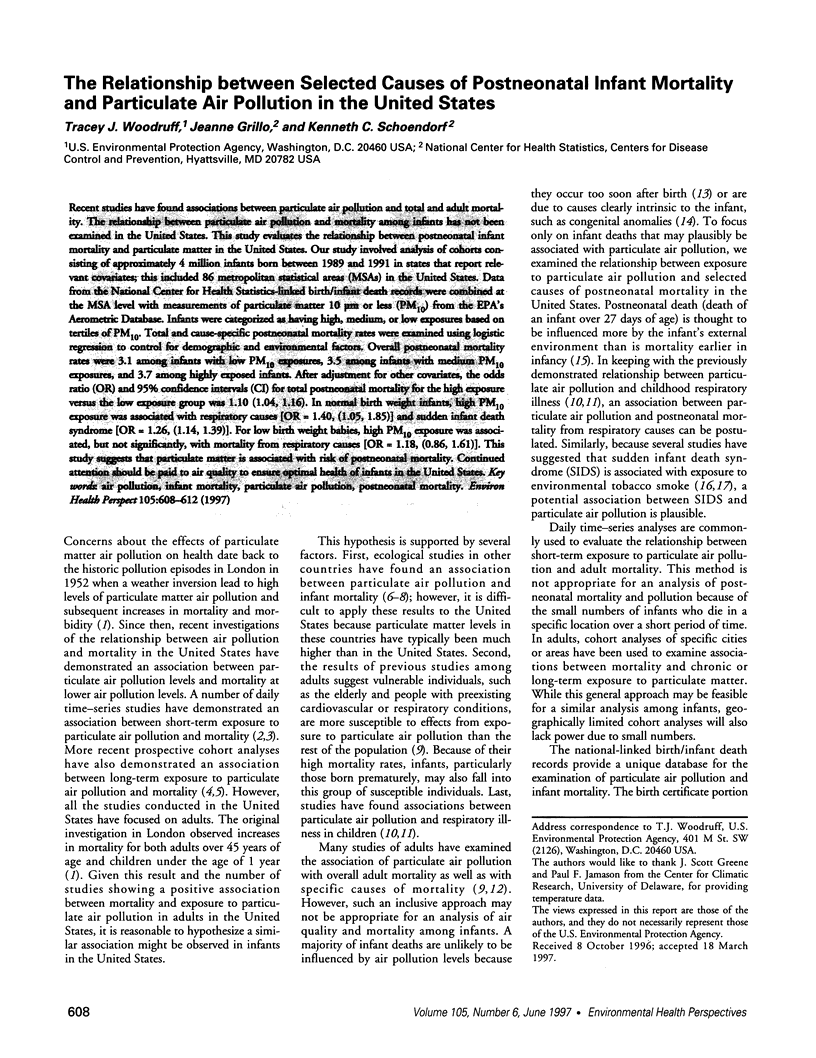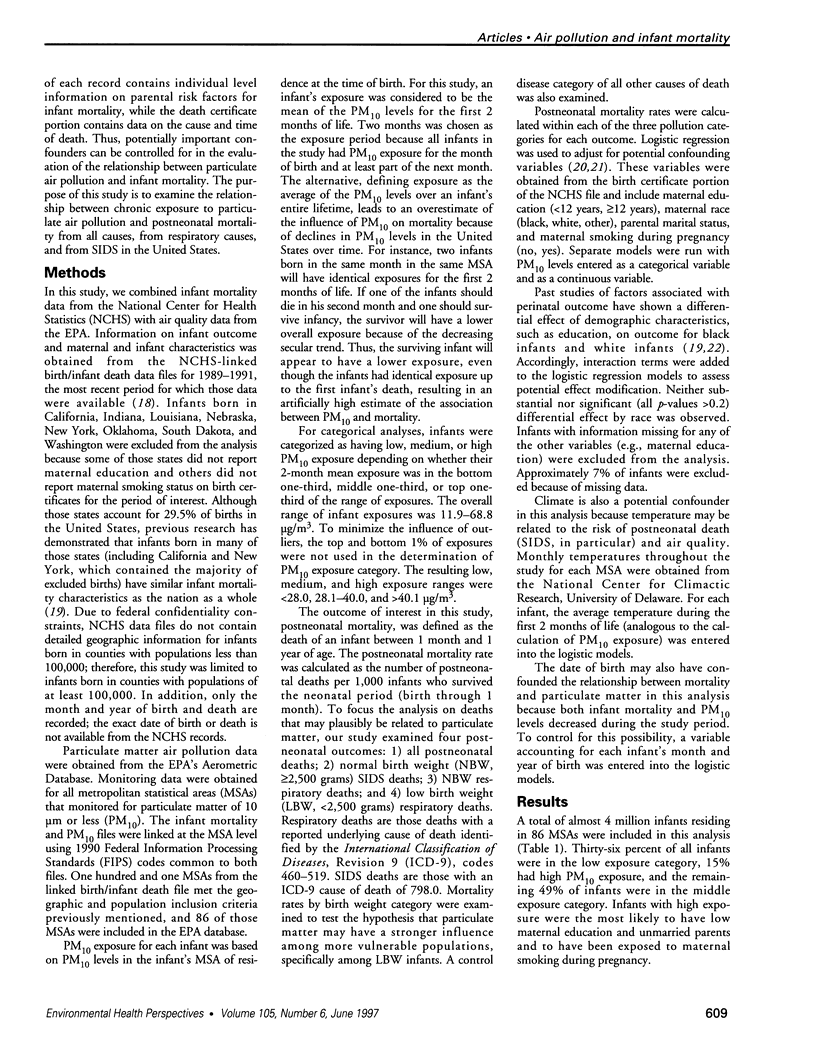Abstract
Recent studies have found associations between particulate air pollution and total and adult mortality. The relationship between particulate air pollution and mortality among infants has not been examined in the United States. This study evaluates the relationship between postneonatal infant mortality and particulate matter in the United States. Our study involved analysis of cohorts consisting of approximately 4 million infants born between 1989 and 1991 in states that report relevant covariates; this included 86 metropolitan statistical areas (MSAs) in the United States. Data from the National Center for Health Statistics-linked birth/infant death records were combined at the MSA level with measurements of particulate matter 10 microns or less (PM10) from the EPA's Aerometric Database. Infants were categorized as having high, medium, or low exposures based on tertiles of PM10. Total and cause-specific postneonatal mortality rates were examined using logistic regression to control for demographic and environmental factors. Overall postneonatal mortality rates were 3.1 among infants with low PM10 exposures, 3.5 among infants with medium PM10 exposures, and 3.7 among highly exposed infants. After adjustment for other covariates, the odds ratio (OR) and 95% confidence intervals (CI) for total postneonatal mortality for the high exposure versus the low exposure group was 1.10 (1.04, 1.16). In normal birth weight infants, high PM10 exposure was associated with respiratory causes [OR = 1.40, (1.05, 1.85)] and sudden infant death syndrome [OR = 1.26, (1.14, 1.39)]. For low birth weight babies, high PM10 exposure was associated, but not significantly, with mortality from respiratory causes [OR = 1.18, (0.86, 1.61)]. This study suggests that particulate matter is associated with risk of postneonatal mortality. Continued attention should be paid to air quality to ensure optimal health of infants in the United States.
Full text
PDF




Selected References
These references are in PubMed. This may not be the complete list of references from this article.
- Bobak M., Leon D. A. Air pollution and infant mortality in the Czech Republic, 1986-88. Lancet. 1992 Oct 24;340(8826):1010–1014. doi: 10.1016/0140-6736(92)93017-h. [DOI] [PubMed] [Google Scholar]
- Burnett R. T., Dales R. E., Raizenne M. E., Krewski D., Summers P. W., Roberts G. R., Raad-Young M., Dann T., Brook J. Effects of low ambient levels of ozone and sulfates on the frequency of respiratory admissions to Ontario hospitals. Environ Res. 1994 May;65(2):172–194. doi: 10.1006/enrs.1994.1030. [DOI] [PubMed] [Google Scholar]
- Dockery D. W., Cunningham J., Damokosh A. I., Neas L. M., Spengler J. D., Koutrakis P., Ware J. H., Raizenne M., Speizer F. E. Health effects of acid aerosols on North American children: respiratory symptoms. Environ Health Perspect. 1996 May;104(5):500–505. doi: 10.1289/ehp.96104500. [DOI] [PMC free article] [PubMed] [Google Scholar]
- Dockery D. W., Pope C. A., 3rd, Xu X., Spengler J. D., Ware J. H., Fay M. E., Ferris B. G., Jr, Speizer F. E. An association between air pollution and mortality in six U.S. cities. N Engl J Med. 1993 Dec 9;329(24):1753–1759. doi: 10.1056/NEJM199312093292401. [DOI] [PubMed] [Google Scholar]
- Hansen H., Kiely M. Importance of the first day death rate in infant mortality. Paediatr Perinat Epidemiol. 1992 Apr;6(2):193–197. doi: 10.1111/j.1365-3016.1992.tb00760.x. [DOI] [PubMed] [Google Scholar]
- Kleinman J. C., Fingerhut L. A., Prager K. Differences in infant mortality by race, nativity status, and other maternal characteristics. Am J Dis Child. 1991 Feb;145(2):194–199. doi: 10.1001/archpedi.1991.02160020086023. [DOI] [PubMed] [Google Scholar]
- Kleinman J. C., Kessel S. S. Racial differences in low birth weight. Trends and risk factors. N Engl J Med. 1987 Sep 17;317(12):749–753. doi: 10.1056/NEJM198709173171207. [DOI] [PubMed] [Google Scholar]
- Klonoff-Cohen H. S., Edelstein S. L., Lefkowitz E. S., Srinivasan I. P., Kaegi D., Chang J. C., Wiley K. J. The effect of passive smoking and tobacco exposure through breast milk on sudden infant death syndrome. JAMA. 1995 Mar 8;273(10):795–798. doi: 10.1001/jama.1995.03520340051035. [DOI] [PubMed] [Google Scholar]
- Knöbel H. H., Chen C. J., Liang K. Y. Sudden infant death syndrome in relation to weather and optimetrically measured air pollution in Taiwan. Pediatrics. 1995 Dec;96(6):1106–1110. [PubMed] [Google Scholar]
- Penna M. L., Duchiade M. P. Air pollution and infant mortality from pneumonia in the Rio de Janeiro metropolitan area. Bull Pan Am Health Organ. 1991;25(1):47–54. [PubMed] [Google Scholar]
- Pharoah P. O., Morris J. N. Postneonatal Mortality. Epidemiol Rev. 1979;1:170–183. doi: 10.1093/oxfordjournals.epirev.a036209. [DOI] [PubMed] [Google Scholar]
- Pope C. A., 3rd, Dockery D. W. Acute health effects of PM10 pollution on symptomatic and asymptomatic children. Am Rev Respir Dis. 1992 May;145(5):1123–1128. doi: 10.1164/ajrccm/145.5.1123. [DOI] [PubMed] [Google Scholar]
- Pope C. A., 3rd Respiratory hospital admissions associated with PM10 pollution in Utah, Salt Lake, and Cache Valleys. Arch Environ Health. 1991 Mar-Apr;46(2):90–97. doi: 10.1080/00039896.1991.9937434. [DOI] [PubMed] [Google Scholar]
- Pope C. A., 3rd, Schwartz J., Ransom M. R. Daily mortality and PM10 pollution in Utah Valley. Arch Environ Health. 1992 May-Jun;47(3):211–217. doi: 10.1080/00039896.1992.9938351. [DOI] [PubMed] [Google Scholar]
- Pope C. A., 3rd, Thun M. J., Namboodiri M. M., Dockery D. W., Evans J. S., Speizer F. E., Heath C. W., Jr Particulate air pollution as a predictor of mortality in a prospective study of U.S. adults. Am J Respir Crit Care Med. 1995 Mar;151(3 Pt 1):669–674. doi: 10.1164/ajrccm/151.3_Pt_1.669. [DOI] [PubMed] [Google Scholar]
- Schoendorf K. C., Kiely J. L. Relationship of sudden infant death syndrome to maternal smoking during and after pregnancy. Pediatrics. 1992 Dec;90(6):905–908. [PubMed] [Google Scholar]
- Schwartz J. Air pollution and daily mortality: a review and meta analysis. Environ Res. 1994 Jan;64(1):36–52. doi: 10.1006/enrs.1994.1005. [DOI] [PubMed] [Google Scholar]
- Schwartz J., Dockery D. W., Neas L. M., Wypij D., Ware J. H., Spengler J. D., Koutrakis P., Speizer F. E., Ferris B. G., Jr Acute effects of summer air pollution on respiratory symptom reporting in children. Am J Respir Crit Care Med. 1994 Nov;150(5 Pt 1):1234–1242. doi: 10.1164/ajrccm.150.5.7952546. [DOI] [PubMed] [Google Scholar]
- Schwartz J., Slater D., Larson T. V., Pierson W. E., Koenig J. Q. Particulate air pollution and hospital emergency room visits for asthma in Seattle. Am Rev Respir Dis. 1993 Apr;147(4):826–831. doi: 10.1164/ajrccm/147.4.826. [DOI] [PubMed] [Google Scholar]
- Schwartz J. What are people dying of on high air pollution days? Environ Res. 1994 Jan;64(1):26–35. doi: 10.1006/enrs.1994.1004. [DOI] [PubMed] [Google Scholar]
- Wallace L. Indoor particles: a review. J Air Waste Manag Assoc. 1996 Feb;46(2):98–126. doi: 10.1080/10473289.1996.10467451. [DOI] [PubMed] [Google Scholar]


